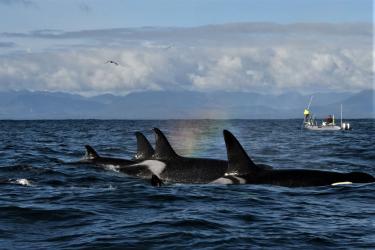Deep-sea corals are among the slowest growing and oldest animals in the ocean, with some species living more than 4,000 years, and support ecosystems of incredible variety and diversity. In fact, 20 percent of all known deep-sea coral species can been found off U.S. coastlines at least 50 meters (164 feet) below the ocean’s surface. Deep-sea sponges can reach the size of a minivan, and may contain treatments for diseases such as pancreatic cancer. Many species create complex habitats that provide shelter, food, and nursery grounds, including for commercially important grouper, snapper, sea bass, rockfish, shrimp, and crab.

Red tree coral with a school of juvenile Pacific cod.
NOAA’s new report, State of Deep-Sea Coral and Sponge Ecosystems of the United States (pdf, 467 pages), explains advances in deep-sea coral research over the past decade and how this new information is shaping deep-sea conservation. Each of the report’s 13 peer-reviewed chapters was written by leading U.S. researchers. Six regional chapters summarize new research—much of it led by NOAA—and explain how results have led to improvements in deep-sea management. It also shares an understanding of coral and sponge taxonomy, species distributions, fisheries habitats, and the effects of human activities.
These chapters serve as a ten-year update to the first State of Deep Coral Ecosystems of the United States report, published in 2007, and provide the first look at U.S. deep-sea sponge ecosystems. Discoveries since the first report have also led to the description and increased understanding of 62 new species of deep-water corals in U.S. waters, and include online, peer-reviewed species lists as a supplement the report.

Iridogorgia soft coral located off the Northwest Hawaiian Islands.
Six additional articles focus on cross-cutting topics including species discovery, interactions between fishing gear and corals/sponges, management of black coral harvests, improvements in habitat modeling, advances in coral ageing and growth rate research, and current knowledge of coral genetics and reproduction. Research presented in this report consolidates our understanding of how deep-sea corals and sponges contribute to resilient ecosystems and sustainable fisheries.
Highlights of the report include the following:
- Sixty-two new species of deep-sea corals described since 2007.
- New diverse and dense deep-sea coral “gardens” discovered in every U.S. region, especially Alaska, where new evidence points to their role as habitat for fisheries of national and international importance.
- Expansion of National Marine Sanctuaries along the West Coast that protect deep-sea corals and sponges.
- Results of a major three-year exploration and research campaign to previously unexplored U.S. Pacific Island slopes, oceanic ridges, and seamounts.
- Deep-sea coral damage and management responses after the Deepwater Horizon oil spill.
- Use of habitat models to aid protection of 38,000 square miles of the Northeast deep sea, which has helped make the U.S. a leader in deep-sea conservation.
- Enhanced protection in the Southeast across areas containing one of the most substantial concentrations of deep-sea coral reefs in the world.
- Updated conservation status and threat analysis for U.S. deep-sea coral and sponge ecosystems reveals progress in conservation and potential implications of emerging industries such as deep-sea mining.
Deep-sea corals and sponges are extremely vulnerable to human activities that damage the seafloor or alter the surrounding environment, and once damaged, may take centuries to recover—if they recover at all. The report serves as a baseline for continued research to further understand and conserve these ecosystems.
NOAA research on deep-sea coral and sponge ecosystems is led by the Deep Sea Coral Research & Technology Program, within the Office of Habitat Conservation, which is dedicated to mapping and characterizing deep-sea ecosystems and sharing information needed to conserve these valuable and vulnerable habitats. The Program works in partnership with several NOAA offices, other federal agencies, and a broad range of academic scientists. Managers are using the NOAA Deep Sea Coral Research and Technology Program’s discoveries and scientific findings to make informed decisions.



